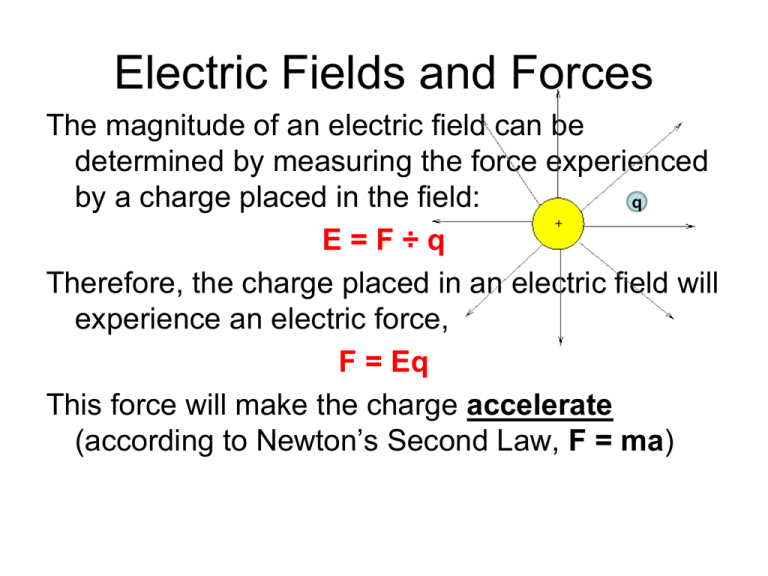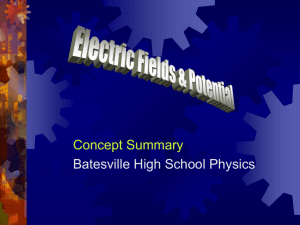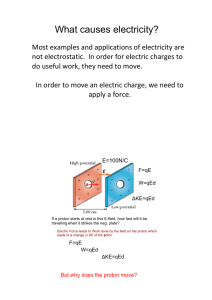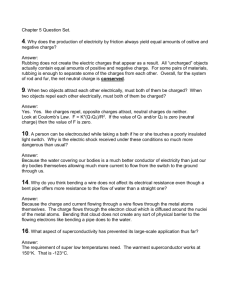electric field
advertisement

Electric Fields and Forces The magnitude of an electric field can be determined by measuring the force experienced by a charge placed in the field: q E=F÷q Therefore, the charge placed in an electric field will experience an electric force, F = Eq This force will make the charge accelerate (according to Newton’s Second Law, F = ma) Electric Fields What direction will a charge accelerate? + + + + + + + + + - Positive charges will accelerate in the same direction as the electric field. Negative charges will accelerate in the opposite direction of the electric field. Conversion of energy Moving a mass or moving a charge takes work energy that is transformed to potential energy and/or to Kinetic energy If you pick up an object in a gravitational field, you have supplied work energy. The object now has potential energy. If you release the object, That potential energy is converted to kinetic energy. Work energy = potential energy = kinetic energy If you move a charge in an electric field, it requires work energy. That work energy is converted to potential energy. When the charge is released, its electric potential energy, is converted to kinetic energy! Work energy = potential energy = kinetic energy E - Move a mass, m Through a gravitational field, g A distance, h Gravitational Potential Energy, mgh Move a charge, q Through an electrical field, E A distance, d Electrical Potential Energy, qEd The work energy required to move a charge through an electric field is given by +++ +++ +++ W = qEd Electric “Pressure” Voltage Voltage can be thought of as a kind of pressure- Electrical Pressure Voltage is also called Electric Potential Think of the water supply at your housesometimes you have high water pressure-water flows quickly- and sometimes low water pressure- water flows slowly. With Higher Voltage (pressure), charges are able to flow more quickly Voltage and Pressure You may have more PRESSURE in a shower nozzle than in a slow moving river, but does the pressure alone tell you how much total water is actually moving? No! The pressure alone does not tell you how much total water was actually flowing. The flow of water is called the “current”. Rub a balloon on your hair and it becomes negatively charged, perhaps to several thousand volts. Does this mean that there’s a lot of electrical energy? Well, the charge transferred to the balloon is typically less than a millionth of a Coulomb (Remember, one Coulomb is charge is a HUGE amount of charge) There’s a LOT of difference Voltage = Energy / charge between Voltage and Energy! Energy = Voltage x charge Energy = 3000 V x 0.000001 C Energy = 0.003 J That’s not much energy! High Voltage does not necessarily mean that there’s a lot of useful energy or that something is dangerous. High Voltage is not necessarily dangerous- a Van de Graaff generator can have more than 400,000 V, but there’s not much charge that is transferred to you from the globe. Low Voltage is not necessarily safe. Our houses are wired with 120V and you can be killed from that electricity. Voltage (potential) is not the dangerous part of electricity. The dangerous part is how many charges are flowing- the “current”. The Electric Potential (Voltage), V, changes as you move from one place to another within an electric field The change in Potential (“pressure”), called the “Potential Difference” is given by DV = Ed Electric Field 3 meters For example, the potential difference between two locations separated by 3 meters in a 4000 N/C electric field is given by DV = Ed = 4000 N/C x 3 m = 12,000 V DV = Ed 4. If the potential changes by 100 V between two locations separated by 5 meters, what is the strength of the electric field? Electric Potential Energy = qEd Electric Potential difference, DV = Ed 5. How much work energy was required to move a 0.8 C charge a distance of 3 meters through a 1200 N/C electric field? 6. What is the potential difference between those two locations? #7 Which image shows the correct electric field lines drawn around two positive charges? A B C #8 A positive charge is released in the electric field as shown below. To which direction will the positive charge accelerate? A. Straight up B. Straight down C. right D. left E. The charge will not move + Electric Potential Energy d Energy stored up between 2 charges separated by a distance d: q1q 2 UE k d Unit: Joules Changing the Electric Potential Energy If you raise or lower a mass in a gravitational field, you change the gravitational potential energy, UG. If you move a charge in an electric field, you change the electric potential energy, UE. Two Ways to Find Electric Potential Energy ? q1q 2 UE k d OR Are these the same thing??? Which equation should be used?? qEd If you RELEASE a charge in an electrical field, its potential energy is converted to kinetic energy! Work enery = potential energy = ½ mv2 E - Examples What is the potential energy stored between 2 charges of 3 C and 4 C separated by 2 m? 5.4 x 1010 J q1q 2 UE k d It takes 2.43 x 10-15 J of work to move an electron as distance of 2 m in an electric field. What is the strength of the field? W = qEd E = 7600 N/C The electron is then released. What is the maximum velocity it will achieve? 2.43 x 10-15 J = W = qEd = ½ mv2 v = 7.3 x 107 m/s If two charges are placed close to each other and held in place, there is an electric potential energy stored between them. + + Two charges in an electric field at the same location will have twice as much electric potential energy as one charge; Five charges will have five time the potential energy, and so on… It is often convenient to consider the electric potential energy per charge. + + + + + Electric potential energy charge The concept of the electric potential energy per charge has a special nameElectric Potential Unit: Joule/coulomb. However, it gets its own unit called a volt. 1 volt = 1 joule / coulomb Since electric potential is measured in volts, it is commonly called Voltage. Electric Potential = Voltage The work energy required to move a charge, q, through an electric field, E, a distance d, is given by +++ +++ +++ W = qEd = qDV Sometimes, a charge is said to be located “at ground”. The potential (voltage) at “ground” is zero. Vground = 0 Volts There is another unit for very tiny amounts of energy associated with atoms and sub-atomic particles. It is called an “electron-Volt” or eV. One electron-Volt is the amount of work energy required to move one electron through 1 Volt of potential difference. In other words, 1 eV = W = qDV = 1.6 x 10-19 C x 1V So the conversion between eV’s and Joules is 1 eV = 1.6 x 10-19 J V = ?? q The Electric Potential, V, due to a point charge, q, is given by q Vk d The potential will have the same sign as the charge- there can be a large positive and a large negative potential At very great distances away from a charge… d is very large… q Vk d The Potential, V, due to that charge is virtually ZERO. Potential due to more than one charge Potential is NOT a vector…. (yea!!!)….So The potential due to a group of point charges is given by q V k d Example What is the potential halfway between 2 charges of 3mC and 4mC located 16 cm apart? 787500V What would be the potential if the 4mC charge were negative? -112500 V q V k d + Higher V Lower V - The potential near a positive charge will be higher (it’s positive!) than the potential near a negative charge (it’s negative!). • Therefore a positive charge will accelerate from high to low V • A negative charge will accelerate from low to high V








